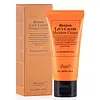What's inside
What's inside
 Key Ingredients
Key Ingredients

 Benefits
Benefits

 Concerns
Concerns

 Ingredients Side-by-side
Ingredients Side-by-side

Water
Skin ConditioningDipropylene Glycol
HumectantCaprylic/Capric Triglyceride
MaskingDaucus Carota Sativa Root Water
MaskingGlycerin
HumectantArachidyl Alcohol
EmollientEthylhexyl Palmitate
EmollientCetearyl Alcohol
Emollient1,2-Hexanediol
Skin ConditioningBehenyl Alcohol
EmollientPanthenol
Skin ConditioningButyrospermum Parkii Butter
Skin ConditioningArachidyl Glucoside
EmulsifyingSorbitan Olivate
EmulsifyingGlyceryl Caprylate
EmollientAmmonium Acryloyldimethyltaurate/Vp Copolymer
Helianthus Annuus Seed Oil
EmollientPropanediol
SolventPentylene Glycol
Skin ConditioningCanola Oil
EmollientSodium PCA
HumectantSodium Gluconate
Skin ConditioningGlycine Soja Oil
EmollientDipotassium Glycyrrhizate
HumectantButylene Glycol
HumectantGlucose
HumectantTocopheryl Acetate
AntioxidantAllantoin
Skin ConditioningHydrogenated Lecithin
EmulsifyingDaucus Carota Sativa Seed Oil
EmollientMelaleuca Alternifolia Leaf Oil
AntioxidantSantalum Album Oil
MaskingCamellia Japonica Flower Extract
EmollientDaucus Carota Sativa Root Extract
Skin ConditioningSodium Hyaluronate
HumectantBixa Orellana Seed Oil
EmollientPhytosteryl/Octyldodecyl Lauroyl Glutamate
Skin ConditioningBeta-Carotene
Skin ConditioningCeramide NP
Skin ConditioningTocopherol
AntioxidantWater, Dipropylene Glycol, Caprylic/Capric Triglyceride, Daucus Carota Sativa Root Water, Glycerin, Arachidyl Alcohol, Ethylhexyl Palmitate, Cetearyl Alcohol, 1,2-Hexanediol, Behenyl Alcohol, Panthenol, Butyrospermum Parkii Butter, Arachidyl Glucoside, Sorbitan Olivate, Glyceryl Caprylate, Ammonium Acryloyldimethyltaurate/Vp Copolymer, Helianthus Annuus Seed Oil, Propanediol, Pentylene Glycol, Canola Oil, Sodium PCA, Sodium Gluconate, Glycine Soja Oil, Dipotassium Glycyrrhizate, Butylene Glycol, Glucose, Tocopheryl Acetate, Allantoin, Hydrogenated Lecithin, Daucus Carota Sativa Seed Oil, Melaleuca Alternifolia Leaf Oil, Santalum Album Oil, Camellia Japonica Flower Extract, Daucus Carota Sativa Root Extract, Sodium Hyaluronate, Bixa Orellana Seed Oil, Phytosteryl/Octyldodecyl Lauroyl Glutamate, Beta-Carotene, Ceramide NP, Tocopherol
Lignum Powder
AbrasiveGlycerin
HumectantCeteareth-20
CleansingGlyceryl Stearate
EmollientAloe Barbadensis Leaf Extract
EmollientCitric Acid
BufferingPotassium Sorbate
PreservativeCocos Nucifera Oil
MaskingCucurbita Pepo Seed Oil
EmollientSolanum Lycopersicum Seed Oil
EmollientCorylus Avellana Seed Oil
EmollientCucumis Sativus Oil
EmollientPrunus Amygdalus Dulcis Oil
Skin ConditioningMacadamia Ternifolia Seed Oil
EmollientPersea Gratissima Oil
Skin ConditioningRosmarinus Officinalis Leaf
Skin ConditioningTocopherol
AntioxidantHelianthus Annuus Seed Oil
EmollientLignum Powder, Glycerin, Ceteareth-20, Glyceryl Stearate, Aloe Barbadensis Leaf Extract, Citric Acid, Potassium Sorbate, Cocos Nucifera Oil, Cucurbita Pepo Seed Oil, Solanum Lycopersicum Seed Oil, Corylus Avellana Seed Oil, Cucumis Sativus Oil, Prunus Amygdalus Dulcis Oil, Macadamia Ternifolia Seed Oil, Persea Gratissima Oil, Rosmarinus Officinalis Leaf, Tocopherol, Helianthus Annuus Seed Oil
Ingredients Explained
These ingredients are found in both products.
Ingredients higher up in an ingredient list are typically present in a larger amount.
Glycerin is already naturally found in your skin. It helps moisturize and protect your skin.
A study from 2016 found glycerin to be more effective as a humectant than AHAs and hyaluronic acid.
As a humectant, it helps the skin stay hydrated by pulling moisture to your skin. The low molecular weight of glycerin allows it to pull moisture into the deeper layers of your skin.
Hydrated skin improves your skin barrier; Your skin barrier helps protect against irritants and bacteria.
Glycerin has also been found to have antimicrobial and antiviral properties. Due to these properties, glycerin is often used in wound and burn treatments.
In cosmetics, glycerin is usually derived from plants such as soybean or palm. However, it can also be sourced from animals, such as tallow or animal fat.
This ingredient is organic, colorless, odorless, and non-toxic.
Glycerin is the name for this ingredient in American English. British English uses Glycerol/Glycerine.
Learn more about GlycerinHelianthus Annuus Seed Oil is the oil derived from the seeds of a Sunflower. Sunflower seed oil is non-fragrant. It is an emollient, meaning it helps to soften the skin.
Sunflower seed oil contains many fatty acids. The fatty acids found in sunflower seeds include (from highest amount to least): linoleic acid, myristic acid, palmitic acid, stearic acid, arachidic acid, oleic acid, and linolenic acid.
These fatty acids help the skin create ceramides. Ceramides play a role in repairing the skin barrier.
Helianthus Annuus Seed Oil helps moisturize the skin. This in turn helps the skin look more rejuvenated and smoother.
Sunflowers are rich in vitamin E.
Historians believe Indigenous cultures of North America domesticated sunflowers before corn. Thus they relied on sunflower oil for a variety of uses. One such use is moisturizing skin and hair.
Sunflower seed oil may not be fungal acne safe. We recommend speaking with a professional if you have any concerns.
Learn more about Helianthus Annuus Seed OilTocopherol (also known as Vitamin E) is a common antioxidant used to help protect the skin from free-radicals and strengthen the skin barrier. It's also fat soluble - this means our skin is great at absorbing it.
Vitamin E also helps keep your natural skin lipids healthy. Your lipid skin barrier naturally consists of lipids, ceramides, and fatty acids. Vitamin E offers extra protection for your skin’s lipid barrier, keeping your skin healthy and nourished.
Another benefit is a bit of UV protection. Vitamin E helps reduce the damage caused by UVB rays. (It should not replace your sunscreen). Combining it with Vitamin C can decrease sunburned cells and hyperpigmentation after UV exposure.
You might have noticed Vitamin E + C often paired together. This is because it is great at stabilizing Vitamin C. Using the two together helps increase the effectiveness of both ingredients.
There are often claims that Vitamin E can reduce/prevent scarring, but these claims haven't been confirmed by scientific research.
Learn more about Tocopherol